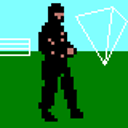Hi, I would like to make some simple 3D wireframe models - such as Elite spaceships, Mercenary buildings, Battlezone etc. I'm talking 80-90's retro wireframe modles here.
Rather than writing my own, I'd like to find something out there which will let me create relatively simple models and export vertex and line information to a simple file format or even C arrays etc.
I don't really want to use something as complicated as Blender if I can avoid it.
Can somebody recommend such a tool?
Thanks.





